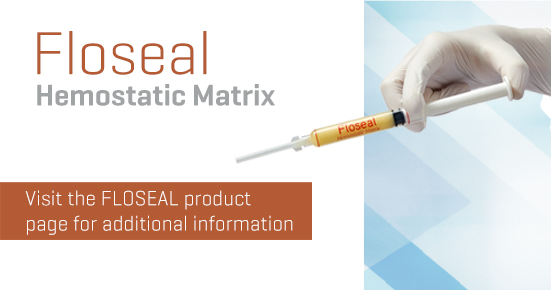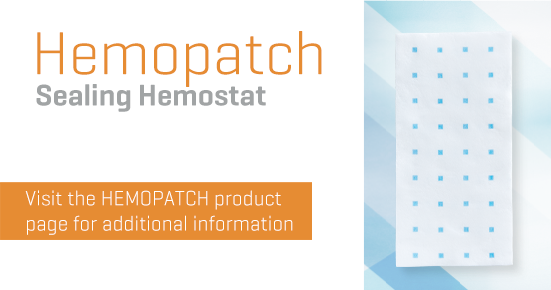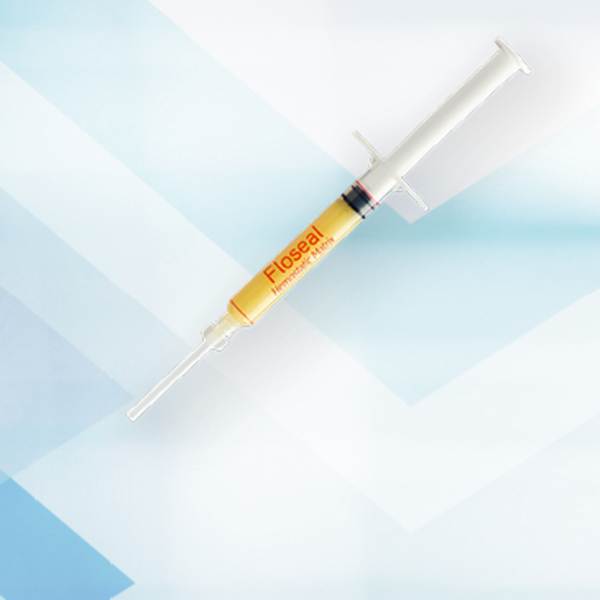Hepatobiliary Surgery
In HPB surgery, multiple factors such as treatment with antiplatelet/anticoagulant therapies as well as resection size and tissue quality can impact intraoperative blood loss1. The extent of blood loss impacts patient morbidity and mortality but may also present risk for longer term oncological outcomes2. In pancreatic surgery, the most serious complication is pancreatic leakage in the form of post-op pancreatic fistula. Baxter’s portfolio of solutions can help promote better outcomes in these challenging procedures.
Each HPB procedure provides unique challenges that can cause complications for the healing process. Here are a few examples:

FLOSEAL in Liver Resection
FLOSEAL, Baxter's flowable hemostat, is highly effective to achieve hemostasis in deep and irregular transection cavities during both open and MIS liver resection procedures. FLOSEAL, provides effective, fast hemostasis in major hepatic surgery to remove primary or metastatic tumors, controlling mild to severe bleeding from the liver edge, even in patients with cirrhotic livers5. A variety of applicator tips and cannulas are available to facilitate FLOSEAL’s application, including sites that are difficult to access.

HEMOPATCH in Liver Resection
HEMOPATCH, Baxter’s collagen pad with NHS-PEG adhesive coating, provides effective hemostasis in open and minimally invasive liver resections with largely plane transection surfaces6. Extensive vascular exposure during liver resections can increase the risk of bleeding and fistula formation. HEMOPATCH can decrease the biliary and hemorrhagic complications in liver applications, providing a strong mechanical bolster to seal even cauterized tissue7. Surgeon preferred for its flexibility/pliability and tissue adherence, HEMOPATCH handles with ease in MIS applications8.
Whipple & Distal Pancreatectomy
Postoperative pancreatic fistula (POPF) is the most common major complication after pancreatectomy and it is a potentially serious and life-threatening complication that may lead to prolonged hospital stay and increased costs9. HEMOPATCH, Baxter’s ready to use advanced patch, provides effective sealing with mechanical strength that may decrease both the incidence and severity of POPFs in both Whipple and distal pancreatectomy procedures10,11.
Portfolio of Products
Floseal Hemostatic Matrix Indication
FLOSEAL is indicated in surgical procedures as an adjunct to hemostasis when control of bleeding, ranging from oozing to spurting, by ligature or conventional procedures is ineffective or impractical.
Contraindications
Do not use FLOSEAL in patients with known allergies to materials of bovine origin.
Warnings
Do not inject or compress FLOSEAL into blood vessels.
Do not apply FLOSEAL in the absence of active blood flow, e.g., while the vessel is clamped or bypassed. Extensive intravascular clotting and even death may result.
FLOSEAL is not intended as a substitute for meticulous surgical technique and the proper application of ligatures or other conventional procedures for hemostasis.
FLOSEAL is not intended to be used as a prophylactic hemostatic agent to prevent postoperative bleeding.
Excess FLOSEAL Matrix (material not incorporated in the hemostatic clot) should always be removed by gentle irrigation from the site of application. Meticulous irrigation is required when used in, around, or in proximity to foramina in bone, areas of bony confine, the spinal cord, the brain and/or cranial nerves.
As with any implantable material, the use of FLOSEAL is not recommended in the presence of an active infection.
FLOSEAL should be used with caution in contaminated areas of the body. If signs of infection or abscess develop where FLOSEAL has been applied, re-operation may be necessary in order to remove the infected material and allow drainage.
Regardless of the type of surgical procedure, surgeons should consider the maximum swell volume of FLOSEAL, which is between 10 – 20%, after product is applied to source of bleeding and its potential effect on the surrounding anatomic areas. Maximum swell volume is achieved within about 10 minutes.
The safety and effectiveness of FLOSEAL for use in ophthalmic procedures has not been established.
FLOSEAL should not be used for controlling intrauterine post-partum bleeding or menorrhagia.
The safety and effectiveness of FLOSEAL has not been established in children and pregnant women.
Do not use FLOSEAL in the closure of skin incisions because it may interfere with the healing of the skin edges due to mechanical interposition of gelatin. The safety and effectiveness of the use of FLOSEAL Matrix as a carrier for antibiotic solutions or powders has not been established.
For safe and proper use of this device, please refer to the Instructions for Use.
CE 0123
HEMOPATCH Indication for Use
HEMOPATCH is intended as a hemostatic device and surgical sealant for procedures in which control of bleeding or leakage of other body fluids or air by conventional surgical techniques is either ineffective or impractical. HEMOPATCH may be used to close dural defects following traumatic injury, excision, retraction or shrinkage of the dura mater.
Contraindications
Do not compress HEMOPATCH into blood vessels or use intravascularly. The device must not be used in patients with known hypersensitivity to bovine proteins or brilliant blue (FD&C Blue No. 1 (Blue 1)).
Warnings
HEMOPATCH is not intended to be used in pulsatile, severe bleedings. The use of HEMOPATCH is not recommended in the presence of an active infection. When used in, around, or in proximity to foramina in bone, areas of bony confine, the spinal cord, the brain and/or cranial nerves, care should be exercised to avoid overpacking, creating the potential for neural damage. HEMOPATCH is not intended as a substitute for meticulous surgical technique and the proper application of ligatures or other conventional procedures for hemostasis and sealing.
CE 0297
